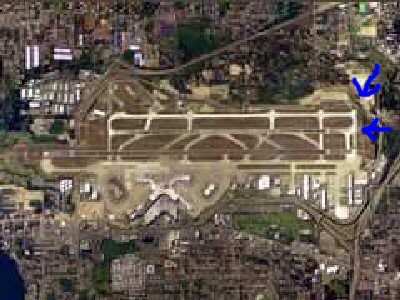Fri, Oct 29, 2010
Agency Highlights Greener Skies Over Seattle Program
 The FAA said Thursday it is awarding its largest Voluntary
Airport Low Emission (VALE) grant for an $18.3 million project at
Seattle-Tacoma International Airport (Sea-Tac) to improve air
quality and to reduce the use of conventional fuels at the
airport.
The FAA said Thursday it is awarding its largest Voluntary
Airport Low Emission (VALE) grant for an $18.3 million project at
Seattle-Tacoma International Airport (Sea-Tac) to improve air
quality and to reduce the use of conventional fuels at the
airport.
With the VALE grant, Sea-Tac will be able to install a
centralized preconditioned air plant that will allow aircraft
arriving at the gates to shut off their auxiliary power units and
connect to a cleaner central heating and cooling system. This
project will greatly reduce aircraft emissions on the ground. Since
the first VALE grant award in 2005, the FAA has funded 40 projects
totaling $83 million dollars.
"This program is helping airports around the country make needed
technological investments so they can be more environmentally
friendly," said U.S. Transportation Secretary Ray LaHood.
FAA Administrator Randy Babbitt announced the grant during a press
conference in Seattle where he highlighted environmental efforts
under way at Sea-Tac and by the Alaska Air Group (AAG) as examples
of the kind of innovative work being done in the aviation
community. "The FAA is encouraging airlines and airports to find
creative ways to reduce aviation's impact on the environment," said
Administrator Babbitt. "NextGen technology will also help aviation
go even greener by significantly reducing the amount of fuel burned
during air travel."
Administrator Babbitt discussed an innovative program under way
in the Sea-Tac area known as the Greener Skies over Seattle
project. The project began in early 2009 with the Alaska Air Group
(AAG), which includes Alaska Airlines and Horizon Airlines, the
Port of Seattle and the Boeing Co. The AAG is seeking to improve
efficiency at Sea-Tac through expanded use of NextGen
satellite-based technologies to provide more direct and optimized
descent paths to landing.

Sea-Tac File Image
The program has the potential to provide environmental benefits
to the region through reducing fuel burn, emissions, and the number
of people impacted by aircraft noise. In addition, lessons and
benefits gained from this effort may be transferred to other
airports around the nation. In mid-2010 Greener Skies over Seattle
became a FAA project and the first phase of Performance Based
Navigation instrument flight procedure development is now under
way.
More News
Pilot Also Reported That Due To A Fuel Leak, The Auxiliary Fuel Tanks Were Not Used On June 4, 2025, at 13:41 eastern daylight time, a Piper PA-23, N2109P, was substantially damage>[...]
From 2023 (YouTube Edition): Reflections on War’s Collective Lessons and Cyclical Nature The exigencies of war ought be colorblind. Inane social-constructs the likes of racis>[...]
Pilot Reported That He Was Unfamiliar With The Single Seat Amateur-Built Airplane And His Intent Was To Perform High-Speed Taxi Testing Analysis: The pilot reported that he was unf>[...]
From 2023 (YouTube Edition): First Kits to Ship October 2023 Having formerly resurrected the storied shape of the Ryan ST—in effigy, anyway—Montrose, Colorado-based Tim>[...]
Performance-Based Navigation (PBN) [ICAO] Area navigation based on performance requirements for aircraft operating along an ATS route, on an instrument approach procedure or in a d>[...]
 NTSB Prelim: Piper PA-23
NTSB Prelim: Piper PA-23 Classic Aero-TV: One Mans Vietnam
Classic Aero-TV: One Mans Vietnam NTSB Final Report: Capella Aircraft Corp FW1C50
NTSB Final Report: Capella Aircraft Corp FW1C50 Classic Aero-TV: Timber Tiger Touts Curtiss Jenny Replicas
Classic Aero-TV: Timber Tiger Touts Curtiss Jenny Replicas ANN's Daily Aero-Term (07.04.25): Performance-Based Navigation (PBN) [ICAO]
ANN's Daily Aero-Term (07.04.25): Performance-Based Navigation (PBN) [ICAO]




